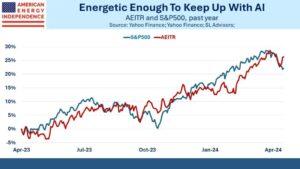Yesterday was the biggest down day of this year. I thought about putting an exclamation point at the end of the prior sentence, but then remembered that this year is only seven weeks old. Down days hurt, but let’s put this one in perspective.
We saw the S&P 500 (SPX) fall by -2% and the NASDAQ 100 (NDX) by 2.4%. This year, SPX had a larger percentage up day on January 6th and NDX had three larger percentage jumps – January 6th and 20th, and February 2nd. There was some shock at those moves’ magnitudes because they may have been abetted by speculators pyramiding “zero-dated” options, but no concern about their direction. They were socially acceptable volatility, after all.
There are some days when I have difficulty explaining why markets move in one direction or another. Yesterday was not one of them. Yields rose sharply across the curve. We have stated repeatedly that if safe assets are getting clobbered, risk assets don’t stand a chance. As of yesterday, 2-year rates had risen 50 basis points this month, with 10 of them coming yesterday. The rise in 10-year rates was “only” 40bp in that timeframe, but yesterday’s 14bp rise didn’t help. Over the same month-to-date period, the declines of less than 1% in major US indices seems like a win in comparison. Throw in some negative guidance from key consumer stocks like Home Depot (HD) and Walmart (WMT) and down we went.
Stocks have been riding a wave of positive momentum, spurred by larger a than usual January effect and a relatively charitable response to most of earnings season. The momentum kept stocks relatively buoyant even as bonds sent a series of negative signals about the near-term path of interest rates. Stock traders feared missing the momentum. Quite frankly, however, FOMO is a powerful but terrible motivator.
In our recent “State of the Markets” piece, we asked four questions that investors needed to address in the coming weeks. They are:
- Are we continuing to fight the Fed, and for how long?
- Are we going to get the hoped-for soft landing?
- Under what circumstances might we get the rate cuts that are being priced into Fed Funds futures?
- How has the plethora of short-term options affected the recent market action?
We’ve begun to get answers to those questions sooner than we might have expected:
- Yes, we’ve been fighting the Fed, but we seem less inclined to do so after a couple of recent declines.
- That seems a lot less likely now that it did just a short while ago. Bonds reconciled themselves to the idea that a soft-landing doesn’t appear imminent more quickly than stocks.
- The circumstances that might bring a rate cut are the same now as then – a weak economy that forces the Fed’s hand (careful what you wish for) or a quick victory in the inflation battle. Recent economic reports and Fed commentary (most recently Bullard and Mester) indicate otherwise. Fed Funds futures are far less hopeful about rate cuts later this year than they were in the immediate aftermath of the FOMC meeting on the first of this month. They were pricing in a bit more than one rate hike, with a peak of 4.9% in June and 1-2 cuts by the end of 2023. They now show a peak rate of 5.34% in July and a full cut is not priced in until January.
- As noted above, it appears that “zero-dated” or “0DTE” options exacerbated some of the big up days that we had recently but appear to have no lasting effect. They’re a tool that could allow speculators to supercharge a rally, but have little effect on other days. (More about 0DTE here)
So far today we’ve had a tepid bounce in bond prices (lower yields) and a churn around unchanged levels in stock indices. Markets usually need to digest big moves, and the expected release of the minutes of the last FOMC meeting may be giving investors some pause. Investors need the occasional reminder that forces other than momentum influence stock prices, that sometimes those influences are negative, and that stocks need to respect moves in other asset classes. Yesterday was one of those reminders.
Disclosure: Interactive Brokers
The analysis in this material is provided for information only and is not and should not be construed as an offer to sell or the solicitation of an offer to buy any security. To the extent that this material discusses general market activity, industry or sector trends or other broad-based economic or political conditions, it should not be construed as research or investment advice. To the extent that it includes references to specific securities, commodities, currencies, or other instruments, those references do not constitute a recommendation by IBKR to buy, sell or hold such investments. This material does not and is not intended to take into account the particular financial conditions, investment objectives or requirements of individual customers. Before acting on this material, you should consider whether it is suitable for your particular circumstances and, as necessary, seek professional advice.
The views and opinions expressed herein are those of the author and do not necessarily reflect the views of Interactive Brokers, its affiliates, or its employees.
Disclosure: Options Trading
Options involve risk and are not suitable for all investors. Multiple leg strategies, including spreads, will incur multiple commission charges. For more information read the "Characteristics and Risks of Standardized Options" also known as the options disclosure document (ODD) or visit ibkr.com/occ










![[Gamma] Scalping Please [Gamma] Scalping Please](https://ibkrcampus.com/wp-content/smush-webp/2024/04/tir-featured-8-700x394.jpg.webp)
![[Gamma] Scalping Please [Gamma] Scalping Please](https://ibkrcampus.com/wp-content/uploads/2024/04/tir-featured-8-700x394.jpg)














